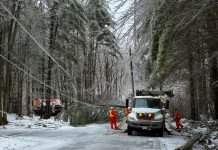
Recently returned from a sea-inspired exhibit on the east coast, Highlands East husband-and-wife artists Gary Blundell and Victoria Ward are excited to bring an exhibit that has been 15 years in the making back home where it all began.
Inspired by an abandoned sawdust burner located near the couple’s log cabin, “Burner Herzog” will be on display at the Agnes Jamieson Gallery at the Minden Hills Cultural Centre from Thursday, August 22 to Saturday, November 23.
In addition to an opening reception on Saturday, August 24, as part of the show, the gallery will be inviting viewers to explore the site of the burner as well as to learn about its history through a film screening.
Exhibited in galleries across Canada and England, Blundell and Ward came upon the site that would inspire “Burner Herzog” by accident circa 2009. Setting out to explore the Harcourt region outside the southern panhandle of Algonquin Provincial Park, the duo discovered the teepee-shaped, corrugated iron structure standing on a site among other abandoned buildings.
“We had no idea what it was, but it looked like something out of Hieronymus Bosch painting,” says Blundell, referring to the 15th-century Dutch painter. “We were really fascinated with it, and started doing some artwork about it.”
While Blundell worked with pastel and acrylic work on paper and wood, Ward worked in mixed media, with their work all centred around logging operations and the patterns it can leave behind on the land. After putting the work on pause, when the pandemic hit 10 years later and the artists were restricted from travelling, they found themselves drawn back to the burner.
“We didn’t feel like we had finished with the site and when we went back, it still had its monumental feel to it,” says Ward. “We decided we’d go back to it every season so we could experience the different ways it felt throughout the year.”

While spending the pandemic focused on revisiting the site, they learned all about its history and its importance to the region through the discovery of an active Facebook group that connected those who once worked for the logging company. Operational from the 1950s to the 1980s, the site processed lumber, turning logs into boards, and the waste and sawdust would go to the burner.
“When we first started working on it, people were saying it’s the only one left standing in Ontario,” says Blundell. “Well, we know that’s not true now because we have found another — one down in Balaclava in Renfrew County — but it’s not a teepee, like this one. It’s just a stack.”
Featuring the duo’s artworks that were done after the initial discovery of the site and during the pandemic, “Burner Herzog” will also include works by André Lapine, a 20th-century artist whose earlier work was focused on logging operations via horse-drawn carriage, as well as artifacts of machinery and blacksmithing.
Those interested in seeing the sawdust burner for themselves can sign up to for an immersive full-day event held by the Agnes Jamieson Gallery on Saturday, September 7. Participants can view and learn about the exhibit, then spend a day driving to the burner, walking through the site, enjoying a lunch provided by Deep Roots Adventure, and hiking to High Falls. The rain date is set for Saturday, September 14.
Interested guests can also attend an evening of educational film screenings at the gallery on Saturday, October 19. During the pandemic while they were learning about the lumber mill, Blundell and Ward were featured in a documentary by Jordan Vanderberg called Blooms about mining in Cobalt, Ontario. After learning about their artwork, Vanderberg also made a short film outlining the history and story of the sawdust burner, also naming it Burner Herzog. After the screening of both films at the gallery, there will be a question-and-answer session with the filmmaker.
For more information on the sawdust burner tour and film screening or to register for either event, email gallery@mindenhills.ca.

“Over the past fifteen years, we watched nature take the site back,” says Blundell, noting that they even saw a big deer buck using the burner to hide out from the weather. “Nature has grown up around it and now there are lots of trees, so it’s not as easy to see. It went back to nature in that short amount of time.”
The intersection of nature and human influence has often been explored throughout Blundell and Ward’s career in arts. Blundell holds a degree in geological engineering and did research for environmental organizations, while Ward previously worked for environmental law and communications firms.
“I’ve always been fascinated with the patterns that have been left behind by past activities on the landscapes that are now being reclaimed by nature,” says Blundell. “That push and pull reminds me of making a piece of artwork — how you build up a surface and pull back something and then build it back up again. A lot of these sites remind me of making art in an odd way.”
As for Ward, who also has a background in theatre, her fascination with these sites comes from a different angle.
“He was taking me to these crazy places, like quarries and old mine sites, and it appealed to the theatre person in me because there seemed to be stories here,” she says. “There’s a story about this place and there’s something going on here that’s very human as well as natural. One of the great stories of being alive is we do stuff, nature tries to take it back, and we do stuff again — it just seems to be inevitable.”
Its appearance in Minden will mark the third time “Burner Herzog” — named for the German filmmaker Werner Herzog who is known for depicting conflicts with nature and, as Blundell describes, “making movies about very strange places on Earth” — is being exhibited.

Debuting at the Orillia Museum of Art and History in spring 2023, it then went on to be included as part of an exhibit called “(Re)Inventing Wilderness” at Owen Sound’s Tom Thomson Art Gallery.
While Blundell and Ward were “thrilled” to have their work displayed alongside work from the gallery’s namesake, they are equally excited to be bringing the exhibit closer to home for the fall.
“Both other iterations of it were amazing,” Ward says. “How do you measure success? We measure it on how great the experiences are and so far, so good. The Agnes Jamieson is going to shape up too, because it’s so local and we get to connect with people.”
Visit www.mindenhills.ca for more information on the Burner Herzog exhibit at the Agnes Jamieson Gallery.
Follow the Minden Hills Cultural Centre on Facebook and Instagram for more details on the events related to the exhibit.
For more information about the work of Gary Blundell and Victoria Ward, visit www.hotspurstudio.com.



























